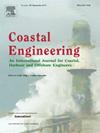Laboratory experiment on the impact of wind on water turbulence in shallow areas
IF 4.5
2区 工程技术
Q1 ENGINEERING, CIVIL
引用次数: 0
Abstract
A series of laboratory experiments focused on the wind impact on the vertical turbulence structure in shallow water has been carried out. The turbulence characteristics in the mid-lower water column under relatively strong wave conditions are investigated. For different experimental conditions (i.e., waves only, wind only, combinations of wind and waves) in a wind-wave flume, the effects of wind and waves were investigated in detail by decomposing the total energy into different terms (i.e., wind-driven currents, wind waves, wind-induced turbulence). The results show that shallow water waves play a major role in transferring energy by non-zero wave-induced Reynolds stress (), turbulent diffusion (). The superimposed wind can further modify the energy transference due to its impact on wave asymmetry and skewness as well as through homogenizing the time-average velocity profiles. Subsequently, the impact of wind on turbulence structure was explored in detail. The most important finding is that the wind can directly influence water turbulent diffusion () along with wave-induced turbulence. The vertical turbulence intensity (σw) is more sensitive to wind than the horizontal turbulence intensity (σu). Furthermore, the major way that wind affects water turbulence is by introducing nonlinear wind and wave interactions, which exhibit a maximum effect (∼60 % compared to the respective effect of wind and wave) at the edge of the bottom boundary layer. This study demonstrates that the wind can transfer momentum downward to mid-lower water columns even under strong waves in shallow waters, which differs from that in deep water systems.
浅水区风对水湍流影响的室内实验
针对风对浅水垂直湍流结构的影响进行了一系列室内实验。研究了较强波浪条件下中下游水柱的湍流特性。针对风浪水槽中不同的实验条件(仅波浪、仅风、风浪组合),通过将总能量分解为不同的项(即风驱动流、风浪、风致湍流),详细研究了风浪的影响。结果表明,浅水波浪通过非零波浪诱导的雷诺应力(u ~ w ~)、湍流扩散(u’w’)在传递能量方面起主要作用。由于叠加风对波的不对称性和偏度的影响,以及通过均匀化时间平均速度剖面,可以进一步改变能量传递。随后,详细探讨了风对湍流结构的影响。最重要的发现是,风可以直接影响水中湍流的扩散(u ‘ w ’形式),同时伴有波浪引起的湍流。垂直湍流强度(σw)比水平湍流强度(σu)对风更为敏感。此外,风影响水湍流的主要方式是通过引入非线性风和波的相互作用,这种相互作用在底部边界层的边缘表现出最大的影响(与风和波各自的影响相比约60%)。本研究表明,与深水系统不同,在浅水强浪条件下,风也能将动量向下传递到中下游水柱。
本文章由计算机程序翻译,如有差异,请以英文原文为准。
求助全文
约1分钟内获得全文
求助全文
来源期刊

Coastal Engineering
工程技术-工程:大洋
CiteScore
9.20
自引率
13.60%
发文量
0
审稿时长
3.5 months
期刊介绍:
Coastal Engineering is an international medium for coastal engineers and scientists. Combining practical applications with modern technological and scientific approaches, such as mathematical and numerical modelling, laboratory and field observations and experiments, it publishes fundamental studies as well as case studies on the following aspects of coastal, harbour and offshore engineering: waves, currents and sediment transport; coastal, estuarine and offshore morphology; technical and functional design of coastal and harbour structures; morphological and environmental impact of coastal, harbour and offshore structures.
 求助内容:
求助内容: 应助结果提醒方式:
应助结果提醒方式:


